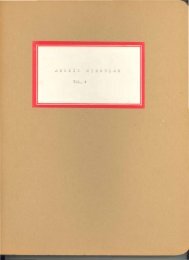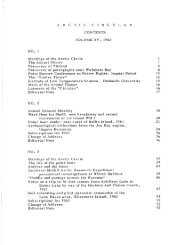Volume 11, 1958 - The Arctic Circle - Home
Volume 11, 1958 - The Arctic Circle - Home
Volume 11, 1958 - The Arctic Circle - Home
You also want an ePaper? Increase the reach of your titles
YUMPU automatically turns print PDFs into web optimized ePapers that Google loves.
VOL XI No. Z THE ARCTIC CIRCULAR 22<br />
the Tunit were the Thule Eskimos, but the evidence indicates rather that<br />
they were the Dorset people.<br />
Signs of a fourth and still earlier people have been found<br />
~ec8Dt1y at several places in the <strong>Arctic</strong>, especially in north Foxe Basin.<br />
We do not know whether these people were Eskimo or not but they were<br />
probably the first people to spread widely over the Canadian <strong>Arctic</strong>, and<br />
arrived there some four to five thousand years ago, probably not long<br />
after the ice had retreated from the land.<br />
History<br />
: <br />
\'.<br />
,t:"<br />
When the Vikings discovered Greenland in the tenth century<br />
they did not see any Eskimos. but they found signs of earlier inhabitants.<br />
<strong>The</strong> first contact between Europeans and Eskimos probably took place<br />
during the Vinland voyages in the first y~ars of the eleventh century when<br />
the Vikings visited Labrador and possibly Baffin Island. <strong>The</strong>y found and<br />
fought with a race whom they called Sk"J-elings and who seem to have been<br />
Eskimos. <strong>The</strong> next heard about the Eskimos is in the fourteenth century<br />
when they moved south down the Greenland coast and met the Norse<br />
colonists. Some time after this the contact between Greenland and<br />
Europe was broken. When it was restored at the end of the sixteenth<br />
century t:'le Eskimos were in complete possession of Greenland. Mystery<br />
surrounds the fate of the Norse. <strong>The</strong>y may have died out, they may have<br />
been killed by the Eskimos. or they may have been absorbed into the<br />
Eskimos. A few ruins were all that was lef~ of the Norse colonies in<br />
Greenland which at one time had a strength Or eight or nine thousand and<br />
had included sixteen churches, a bishop, a monastery. and a convent•<br />
.j'.,<br />
: \) ()<br />
'.1.\'<br />
'k-<br />
J<br />
<strong>The</strong> first contact with the Eskimos in the Canadian north was<br />
when Frobisher discovered the Canadian <strong>Arctic</strong> in 1516. He met a number<br />
of Eskimos during his three voyages but his relations with them were<br />
unhappy. He captured SOme of them and they captured some of his men,<br />
and each side developed a hearty dislike for the other. Frobisher was<br />
followed by other explorers many of whom met the Eskimos and left<br />
accounts of them so that the limits of the country they occupied were<br />
more or less known by the end of the eighteenth century. It was Parry's<br />
second expedition 1821-3 however that seems to have been responsible<br />
for arousing popular interest in the Eskimos. He spent two winters in<br />
Foxe Basin in the c entre of the Eskimo country and both he and his second<br />
in command Lyon left excellent accounts which were widely read in<br />
England and elsewhere. It is probably from their accounts that most of<br />
the children's storieo about Eskimos spring. <strong>The</strong> most important<br />
influence on the Canadian Eskimos in the nineteenth century was not<br />
however the explorer but the whaler. <strong>The</strong>re were two types of whalers,












